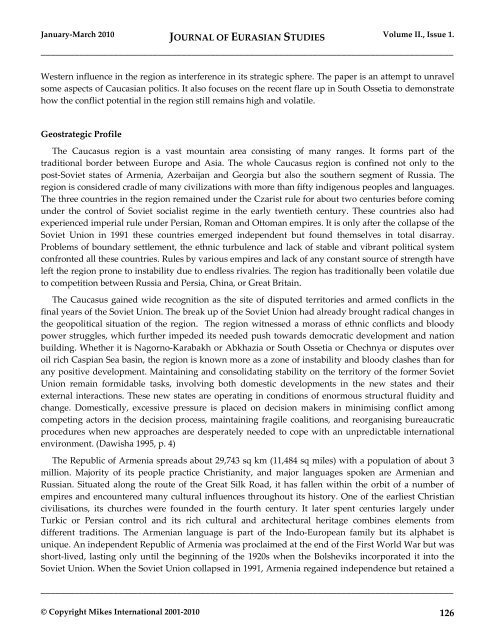EurasianStudies_0110..
EurasianStudies_0110..
EurasianStudies_0110..
Create successful ePaper yourself
Turn your PDF publications into a flip-book with our unique Google optimized e-Paper software.
January-March 2010 JOURNAL OF EURASIAN STUDIES Volume II., Issue 1.<br />
_____________________________________________________________________________________<br />
Western influence in the region as interference in its strategic sphere. The paper is an attempt to unravel<br />
some aspects of Caucasian politics. It also focuses on the recent flare up in South Ossetia to demonstrate<br />
how the conflict potential in the region still remains high and volatile.<br />
Geostrategic Profile<br />
The Caucasus region is a vast mountain area consisting of many ranges. It forms part of the<br />
traditional border between Europe and Asia. The whole Caucasus region is confined not only to the<br />
post-Soviet states of Armenia, Azerbaijan and Georgia but also the southern segment of Russia. The<br />
region is considered cradle of many civilizations with more than fifty indigenous peoples and languages.<br />
The three countries in the region remained under the Czarist rule for about two centuries before coming<br />
under the control of Soviet socialist regime in the early twentieth century. These countries also had<br />
experienced imperial rule under Persian, Roman and Ottoman empires. It is only after the collapse of the<br />
Soviet Union in 1991 these countries emerged independent but found themselves in total disarray.<br />
Problems of boundary settlement, the ethnic turbulence and lack of stable and vibrant political system<br />
confronted all these countries. Rules by various empires and lack of any constant source of strength have<br />
left the region prone to instability due to endless rivalries. The region has traditionally been volatile due<br />
to competition between Russia and Persia, China, or Great Britain.<br />
The Caucasus gained wide recognition as the site of disputed territories and armed conflicts in the<br />
final years of the Soviet Union. The break up of the Soviet Union had already brought radical changes in<br />
the geopolitical situation of the region. The region witnessed a morass of ethnic conflicts and bloody<br />
power struggles, which further impeded its needed push towards democratic development and nation<br />
building. Whether it is Nagorno-Karabakh or Abkhazia or South Ossetia or Chechnya or disputes over<br />
oil rich Caspian Sea basin, the region is known more as a zone of instability and bloody clashes than for<br />
any positive development. Maintaining and consolidating stability on the territory of the former Soviet<br />
Union remain formidable tasks, involving both domestic developments in the new states and their<br />
external interactions. These new states are operating in conditions of enormous structural fluidity and<br />
change. Domestically, excessive pressure is placed on decision makers in minimising conflict among<br />
competing actors in the decision process, maintaining fragile coalitions, and reorganising bureaucratic<br />
procedures when new approaches are desperately needed to cope with an unpredictable international<br />
environment. (Dawisha 1995, p. 4)<br />
The Republic of Armenia spreads about 29,743 sq km (11,484 sq miles) with a population of about 3<br />
million. Majority of its people practice Christianity, and major languages spoken are Armenian and<br />
Russian. Situated along the route of the Great Silk Road, it has fallen within the orbit of a number of<br />
empires and encountered many cultural influences throughout its history. One of the earliest Christian<br />
civilisations, its churches were founded in the fourth century. It later spent centuries largely under<br />
Turkic or Persian control and its rich cultural and architectural heritage combines elements from<br />
different traditions. The Armenian language is part of the Indo-European family but its alphabet is<br />
unique. An independent Republic of Armenia was proclaimed at the end of the First World War but was<br />
short-lived, lasting only until the beginning of the 1920s when the Bolsheviks incorporated it into the<br />
Soviet Union. When the Soviet Union collapsed in 1991, Armenia regained independence but retained a<br />
_____________________________________________________________________________________<br />
© Copyright Mikes International 2001-2010 126

















